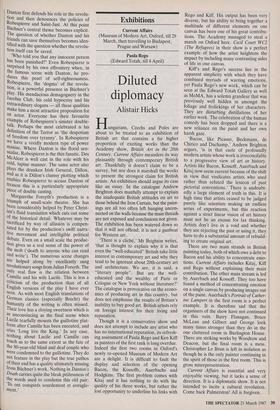Exhibitions
Current Affairs (Museum of Modern Art, Oxford, till 29 March, then travelling to Budapest, Prague and Warsaw) Paula Rego (Edward Totah, till 4 April)
Diluted diplomacy
Alistair Hicks
Hungarians, Czechs and Poles are about to be treated to an exhibition of British art that contains a far higher proportion of exciting works than the Academy show, British Art in the 20th Century. Current Affairs meanders its way pleasantly through contemporary British art. Thankfully it doesn't claim to be a survey, but nor does it marshall the works to present the strongest claim for British artists. An exhibition should argue its case like an essay. In the catalogue Andrew Brighton does manfully attempt to explain the inadequate British attitudes on art to those behind the Iron Curtain, but the paint- ings are all too often left hanging uncon- nected on the walls because the main threads are not exposed and conclusions not given. The exhibition has been watered down so that it will not offend; it is not a gunboat for Western art.
`There is a cliché,' Mr Brighton writes, 'that is thought to explain why it is that even the "well-educated" British take little interest in contemporary art and why they tend to be ignorant about 20th-century art and architecture. We are, it is said, a "literary people". But are the well- educated and the wealthy of Paris or Cologne or New York without literature?' The catalogue is provocative on the econo- mics of producing art in this country, but does not emphasise the results of Britain's inability to buy good art. British artists rely on foreign interest for their living and reputation.
Though it is a conservative show and does not attempt to include any artist who has no international reputation, its refresh- ing assessment of Paula Rego and Ken Kiff as painters of the first rank is long overdue. Indeed the first two rooms in Oxford's newly re-opened Museum of Modern Art are a delight. It is difficult to fault the display and selection of the opening Bacon, the Kossoffs, Auerbachs and Hodgkins. The first problem comes with Kitaj and it has nothing to do with the quality of his three works, but rather the lost opportunity to underline his links with Rego and Kiff. His output has been very diverse, but his ability to bring together a multitude of different elements on one canvas has been one of his great contribu- tions. The Academy managed to steal a march on Oxford here. Cecil Court WC2 (The Refugees) in their show is a perfect example of how the artist heightens the impact by including many contrasting sides of life in one canvas.
Kiff's and Rego's success lies in the apparent simplicity with which they have combined myriads of warring emotions, yet Paula Rego's new work, which can be seen at the Edward Totah Gallery as well as MoMA, has a solemn grandeur that was previously well hidden in amongst the foliage and frolickings of her characters. They are disturbing distillations of her earlier work. The celebration of the human comedy has been dropped and there is a new reliance on the paint and her own harsh gaze.
`Bacon, like Picasso, Beckmann, de Chirico and Duchamp,' Andrew Brighton argues, 'is in that caste of profoundly modern artists whose work is irreconcilable to a progressive view of art or history. Artists like Bacon, Kossoff, Auerbach and Kitaj now seem current because of the shift in view that vindicates artists who used rather than refuted the lexicon of past pictorial conventions.' There is undoubt- edly a large element of truth in this. It is high time that artists ceased to be judged purely like scientists making an endless series of experiments, but this reaction against a strict linear vision of art history must not be an excuse for lax thinking. Artists don't live in a void and whether they are rejecting the past or using it, they have to do a substantial amount of rebuild- ing to create original art.
There are two main strands in British painting today, both of which owe a debt to Bacon and his ability to concentrate emo- tions. Current Affairs includes Kitaj, Kiff and Rego without explaining their main contribution. The other main stream is led by Auerbach and Kossoff. They too have found a method of concentrating emotion on a single canvas by producing images out of the paint. Auerbach's Portrait of Cather- ine Lampert in the first room is a perfect example. It is therefore sad that the organisers of the show have not continued in this vein. Barry Flanagan, Bruce McLean and Gilbert and George look many times stronger than they do in the one cluttered room in Burlington House. There are striking works by Woodrow and Deacon, but the final room is a mess. Christopher Le Brun is left in isolation as though he is the only painter continuing in the spirit of those in the first room. This is gross misrepresentation.
Current Affairs is essential and very enjoyable viewing, but it lacks a sense of direction. It is a diplomatic show. It is not intended to incite a cultural revolution. Come back Palmerston! All is forgiven.


















































 Previous page
Previous page